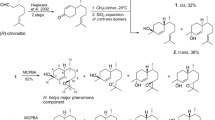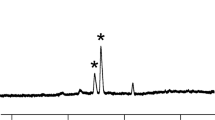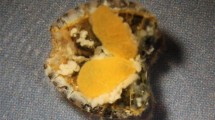Abstract
A two-component pheromone, (3S,6S,7R,10S)- and (3S,6S,7R,10R)-10,11-epoxy-1-bisabolen-3-ol (murgantiol), present in emissions from adult male harlequin bugs, Murgantia histrionica, is most attractive in field bioassays to adults and nymphs in the naturally occurring ratio of ca. 1.4:1. Each of the two individual synthetic stereoisomers is highly attractive to male and female adults and nymphs, but is more attractive in combination and when deployed with a harlequin bug host plant. Blends of 8 stereoisomers also are highly attractive, suggesting that isomers not found in the natural pheromone are not repellent. Deployment of an inexpensive non-stereospecific synthetic pheromone holds promise for efficient trapping and/or use in trap-crops for this important pest in North America.



Similar content being viewed by others
References
Aldrich JR, Hoffmann MP, Kochansky JP, Lusby WR, Eger JE, Payne JA (1991) Identification and attractiveness of a major pheromone component for Nearctic Euschistus spp. stink bugs (Heteroptera: Pentatomidae). Environ Entomol 20:477–483
Aldrich JR, Avery JW, Lee CJ, Graf JC, Harrison DJ, Bin F (1996) Semiochemistry of cabbage bugs (Heteroptera: Pentatomidae: Eurydema and Murgantia). J Entomol Sci 31:172–182
Chittenden FH (1920) Harlequin cabbage bug and its control. USDA Farmers’ Bull 1061:16
Čokl A, Prešern J, Virant-Doberlet M, Bagwell GJ, Millar JG (2004) Vibratory signals of the harlequin bug and their transmission through plants. Physiol Entomol 29:372–380
Hagiwara H, Okabe T, Ono H, Kamat VP, Hoshi T, Suzuki T, Ando MJ (2002) Total synthesis of bisabolane sesquiterpenoids, α-bisabol-1-one, curcumene, curcuphenol and elvirol: utility of catalytic enamine reaction in cyclohexenone synthesis. Chem Soc Perkin Trans 1(7):895–900
Helmey-Hartman WL, Miller CW (2014) Context-dependent mating success in Murgantia histrionica (Hemiptera: Pentatomidae). Ann Entomol Soc Am 107:264–273
James DG, Heffer R, Amaike M (1996) Field attraction of Biprorulus bibax Breddin (Hemiptera: Pentatomidae) to synthetic aggregation pheromone and (E)-2-hexenal, a pentatomid defense chemical. J Chem Ecol 22:1697–1708
Khrimian A, Shearer PW, Zhang A, Hamilton GC, Aldrich JR (2008) Field trapping of the invasive brown marmorated stink bug, Halyomorpha halys, with geometric isomers of methyl 2,4,6-decatrienoate. J Agric Food Chem 56:197–203
Khrimian A, Shirali S, Vermillion KE, Siegler MA, Guzman F, Chauhan K, Aldrich JR, Weber DC (2014a) Stereochemical determination of the aggregation pheromone of harlequin bug, Murgantia histrionica (Hemiptera: Pentatomidae). J. Chem. Ecol., in press.
Khrimian A, Zhang A, Weber DC, Ho H-Y, Aldrich JR, Vermillion KE, Siegler MA, Shirali S, Guzman F, Leskey TC (2014b) Discovery of the aggregation pheromone of the brown marmorated stink bug (Halyomorpha halys) through the creation of stereoisomeric libraries of 1-bisabolen-3-ols. J Nat Prod 77:1708–1717
Krupke CH, Brunner JF, Doerr MD, Kahn AD (2001) Field attraction of the stink bug Euschistus conspersus (Hemiptera: Pentatomidae) to synthetic pheromone-baited host plants. J Econ Entomol 94:1500–1505
Krupke CH, Jones VP, Brunner JF (2006) Diel periodicity of Euschistus conspersus (Heteroptera: Pentatomidae) aggregation, mating and feeding. Ann Entomol Soc Am 99:169–174
Krupke CH, Jones VP, Brunner JF (2011) Evaluating aggregation membership and copulatory success in the stink bug, Euschistus conspersus, using field and laboratory experiments. J Insect Sci 11:2
Leal WS, Higuchi H, Mizutani N, Nakamori H, Kadosawa T, Ono M (1995) Multifunctional communication in Riptortus clavatus (Heteroptera: Alydidae): Conspecific nymphs and egg parasitoid Ooencyrtus nezarae use the same adult attractant pheromone as chemical cue. J Chem Ecol 21:973–985
Leskey TC, Wright SE, Short BD, Khrimian A (2012) Development of behaviorally based monitoring tools for the brown marmorated stink bug, Halyomorpha halys (Stål) (Heteroptera: Pentatomidae) in commercial tree fruit orchards. J Entomol Sci 47:76–85
Lowry, R (2014) VassarStats: Website for Statistical Computation. http://vassarstats.net. Accessed 30 May
Ludwig SW, Kok LT (1998) Evaluation of trap crops to manage harlequin bugs, Murgantia histrionica (Hahn) (Hemiptera: Pentatomidae) on broccoli. Crop Prot 17:123–128
Mendel Z, Jasrotia P, Protasov A, Kol-Maimon H, Zada AL, Franco JC (2012) Responses of second-instar male nymphs of four mealybug species (Hemiptera: Pseudococcidae) to conspecific and heterospecific female sex pheromones. J Insect Behav 25:504–513
Millar JG (2005) Pheromones of true bugs. Top Curr Chem 240:37–84
Panizzi AR (1997) Wild hosts of pentatomids: ecological significance and role in their pest status on crops. Annu Rev Entomol 42:99–122
Pezzullo JC (2014) The Interactive Statistical Pages. (http://StatPages.org) (Accessed 30 May)
SAS Institute (1998) StatView, vol 2. SAS Institute, Cary, NC
Sant’Ana J, Bruni R, Abdul-Baki AA, Aldrich JR (1997) Pheromone-induced movement of nymphs of the predator, Podisus maculiventris (Heteroptera: Pentatomidae). Biol Control 10:123–128
Wallingford AK (2012) Investigating host plant selection of harlequin bug, Murgantia histrionica (Hahn), in order to improve a trap cropping system for its management. Dissertation, Virginia Polytechnic Institute and State University, Blacksburg, VA, USA
Wallingford AK, Kuhar TP, Pfeiffer DG, Tholl DB, Freeman JH, Doughty HB, Schultz PB (2013) Host plant preference of harlequin bug (Hemiptera: Pentatomidae), and evaluation of a trap cropping strategy for its control in collard. J Econ Entomol 106:283–288
Wallingford AK, Kuhar TP, Schultz PB, Freeman JH (2011) Harlequin bug biology and pest management in Brassicaceous crops. J Integr Pest Mgmt 2:H1–H4
Weber DC, Leskey TC, Cabrera Walsh G, Khrimian A (2014) Synergy of aggregation pheromone with methyl (E, E, Z)-2,4,6-decatrienoate in attraction of Halyomorpha halys(Hemiptera: Pentatomidae). J Econ Entomol 107:1061–1068
Zahn DK, Moreira JA, Millar JG (2008) Identification, synthesis, and bioassay of a male-specific aggregation pheromone from the harlequin bug, Murgantia histrionica. J Chem Ecol 34:238–251
Zahn DK, Moreira JA, Millar JG (2012) Erratum to: Identification, synthesis, and bioassay of a male-specific aggregation pheromone from the harlequin bug, Murgantia histrionica. J Chem Ecol 38:126–126
Zar JH (2009) Biostatistical analysis, 5th edn. Pearson Publishing, Upper Saddle River, NJ
Acknowledgments
We are grateful to Matt Klein, Emily Hren, Evan Hoki, and Brennan Bathauer, who assisted with field trials, and to Fil Guzman and Shyam Shirali, who prepared pheromones and lures. Thanks to the BARC-West Farm Crew -- Ted Currier, George Meyers, John Booma, and Stuart McMaster -- for planting and maintaining the experimental fields.
Conflicts of Interests
Authors declare no conflicts of interest.
Author information
Authors and Affiliations
Corresponding author
Additional information
Mention of commercial products is solely for the purpose of providing specific information and does not imply recommendation or endorsement by the United States Department of Agriculture.
Electronic supplementary material
Supplementary Information: Figures S1 (photographs of traps and trap plants), S2 (diagrams of 2-way and 7-way field choice arenas), and text describing lure preparation and loading.
ESM 1
(DOCX 248 kb)
Rights and permissions
About this article
Cite this article
Weber, D.C., Cabrera Walsh, G., DiMeglio, A.S. et al. Attractiveness of Harlequin Bug, Murgantia histrionica, Aggregation Pheromone: Field Response to Isomers, Ratios, and Dose. J Chem Ecol 40, 1251–1259 (2014). https://doi.org/10.1007/s10886-014-0519-9
Received:
Revised:
Accepted:
Published:
Issue Date:
DOI: https://doi.org/10.1007/s10886-014-0519-9
Keywords
- Murgantiol
- Trap plant
- Pheromone trap
- (3S,6S,7R,10S)-10,11-epoxy-1-bisabolen-3-ol, (3S,6S,7R,10R)-10,11-epoxy-1-bisabolen-3-ol
- (1S,4S)-4-((R)-4-((S)-3,3-dimethyloxiran-2-yl)butan-2-yl)-1-methylcyclohex-2-enol
- (1S,4S)-4-((R)-4-((R)-3,3-dimethyloxiran-2-yl)butan-2-yl)-1-methylcyclohex-2-enol, Hemiptera, Pentatomidae, insect pest, pest management




